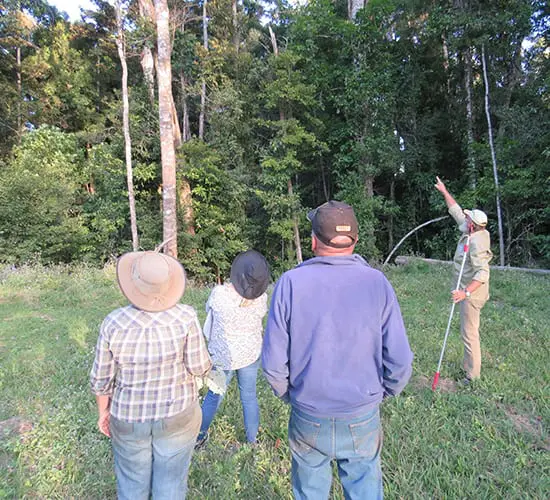
Eungella cluster plans to protect rainforest and farming land

Peter Alden, Pioneer Catchment Landcare, explaining the role of climbing plants in canopies.
Rainforests are the undisputed champions of biodiversity among the world’s ecosystems.
The Eungella Rainforest Cluster Group recognises this and has adopted an holistic approach to rehabilitate remnant rainforest, and to put in place management plans to ensure the rainforest and surrounding farms is protected from future threats.
Disasters bring out the best in people.
When 110,000ha of national park and surrounds was destroyed by bushfire at Eungella in 2018, a group of local landholders got together to work on a recovery plan.
The Eungella Rainforest Cluster Group was born. Initially the aim of the group was two-fold — to rehabilitate remnant rainforest, and to develop management plans to ensure their properties would be protected from future fire threats.
LDC enlisted the expertise of Pioneer Catchment & Landcare (PCL) to work with the nine-member cluster group to complete a fire restoration and revegetation project.
During the past 12 months the goals have broadened. The cluster group has shown an interest in being able to identify plant species, to understand the biodiversity of the rainforest, and to be able to propagate to safeguard species.
Weed management has become a focus, as well as exploring vegetative barriers as an alternative to conventional soil and water conservation structures.
A Vetiver grass erosion control trial is underway to determine if Vetiver grass barriers could provide an effective, low-cost system of soil and water conservation, and provide steep-slope stabilisation and rehabilitation.
Vetiver is tolerant to highly adverse conditions, and its thick root system binds the soil and at the same time makes it difficult to dislodge. This root system makes Vetiver tolerant to drought.
A revegetation trial of a recently-cleaned farm dam using lowland riparian species is also underway.
Many native plant species can recover post-fire, but conditions often favour non-native species.
The cluster group hopes to learn more about how fire impacts lowland riparian ecosystems to help inform management, restoration, and post-fire rehabilitation.
Natural and assisted regeneration and weed control in fire-affected rainforest areas is well underway.

Pictured (from left) are: LDC Land Management Support Coordinator Rodger Walker, Mackay Natural Environment Centre’s Carolyn Wilkes, Reef Catchments’ Julia Kasiske, Ecologist from Pioneer Catchment Landcare Peter Alden, Pioneer Catchment Landcare Project Officer Tom Crow and Pioneer Catchment Landcare Coordinator Nichole Zara.
The group is developing a roadmap so they can take an integrated approach to weed management.
It is also exploring the processes and practicalities of using compost teas to improve soil health and plant growth in the Eungella region, a high rainfall area.
The Eungella Rainforest Cluster Group met in August to inspect trial sites to see what was working well. There were 13 attendees, including representatives from NQ Dry Tropics, PCL, and Reef Catchments.
Guest speaker Carolyn Wilkes, from Mackay Natural Environment Centre (MNEC), spoke about native plants and biodiversity, and the resources available.
The MNEC nursery specialises in supplying tube stock for revegetation projects in Central Queensland.
Peter Alden, Pioneer Catchment Landcare, explained the lifecycle and role of common plants that occupy a ridgeline along Dalrymple Road, near Eungella.
Broad scope
The Eungella Rainforest Cluster Group is addressing a range of issues:
- how to correctly identify the difference between native regrowth and unwanted weeds within burnt forest;
- how to implement best management practices to tackle weeds;
- the dos and don’ts of clearing burnt vegetation;
- how to tackle erosion issues in areas impacted by fire;
- the possibility of using seed bombs to rehabilitate sections of burnt forest;
- using Vetiver grass to help reduce erosion risk on steep banks and scars; and
- the use of compost tea on pasture.


